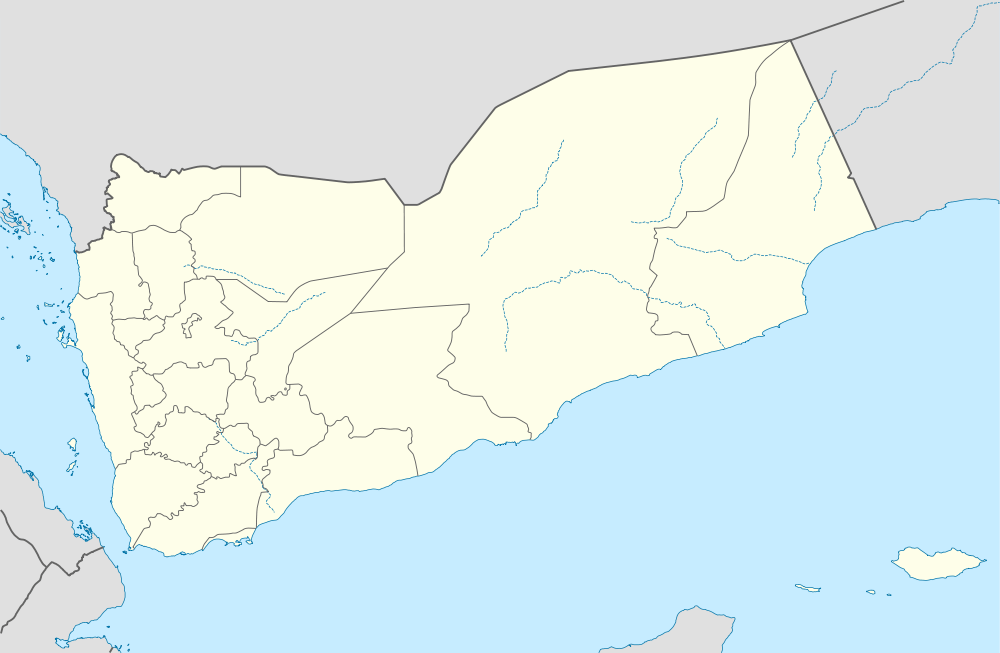Taiz
| Taiz تعز (Taʿizz) | |
|---|---|
 | |
 Taiz Location in Yemen | |
| Coordinates: 13°34′44″N 44°01′19″E / 13.57889°N 44.02194°E | |
| Country | Yemen |
| Governorate | Taiz |
| Population (2014) | |
| • Total |
615,222 |
| Time zone | Yemen Standard Time (UTC+3) |


Taiz (Arabic: تعز Taʿizz) is a city in the Yemeni Highlands, near the famous Mocha port on the Red Sea, lying at an elevation of about 1,400 metres above sea level and Sabir Mountain rises the 3,006 metres above the city. It is the capital of Taiz Governorate. With a population of over 600,000 in 2005, it is the third largest city in Yemen after the capital Sana'a and the southern port of Aden.
History
Overview
In 130 CE the Jewish quarter was established in the city.
The name of the city appeared first at the 6th century of Hijra, 12th CE, when CEO Mahdi, the brother of Salah ad-Din, arrived in Yemen in the year 1173 CE. Taiz was refortified by Salah ad-Din's brother, Taktakeen, the Ayyubid.
The second Rasulid King, Almaddhafar (1288 CE), established Taiz as the second capital of the Rasulid Dynasty after Zabid. Ibn Battutah visited Taiz in the fourteenth century and described it as one of the largest and most beautiful cities of Yemen.
Taiz remained a walled city until 1948 when Imam Ahmed made it the second capital of Yemen, allowing for expansion beyond its fortified wall.
During the 2011 Yemeni uprising fighting in Taiz resulted in anti-government forces seizing control of the city. On 22 March 2015, the Houthis and forces loyal to former president Ali Abdullah Saleh took the city in the aftermath of their coup d'état in Sana'a.[1]
Chronology
1175: Taiz is made capital of Yemen as it was incorporated into dominions of the Ayyubid dynasty by Turan-Shah.
1500 (approximately): The capital is moved to Sana'a by the ruler of the Taharid dynasty.
1516: Taiz comes under Ottoman control.
1918: The Ottomans lose Taiz to the new independent Yemen.
1948: Taiz becomes the administrative capital of Yemen, as it is made the residence of the imam.
1962: State administrations move back to Sana'a.
1960s: The first purified water system in Yemen is opened in Taiz.
Geography
Climate
Taiz has a tropical savanna climate which is slightly moderated by the altitude. The average daily temperature high during August is 33 °C (91 °F). Annual rainfall of Taiz is around 600 millimetres (24 in), but on Jabal Sabir it is probably around 1 metre (39.4 in) per year.
| Climate data for Taiz | |||||||||||||
|---|---|---|---|---|---|---|---|---|---|---|---|---|---|
| Month | Jan | Feb | Mar | Apr | May | Jun | Jul | Aug | Sep | Oct | Nov | Dec | Year |
| Average high °C (°F) | 26.3 (79.3) |
27.4 (81.3) |
27.9 (82.2) |
28.3 (82.9) |
29.0 (84.2) |
31.3 (88.3) |
32.5 (90.5) |
31.7 (89.1) |
31.3 (88.3) |
31.1 (88) |
29.6 (85.3) |
27.1 (80.8) |
29.46 (85.02) |
| Average low °C (°F) | 14.1 (57.4) |
15.3 (59.5) |
17.3 (63.1) |
18.8 (65.8) |
19.5 (67.1) |
19.9 (67.8) |
20.2 (68.4) |
19.1 (66.4) |
17.8 (64) |
16.9 (62.4) |
15.7 (60.3) |
14.9 (58.8) |
17.5 (63.5) |
| Average rainfall mm (inches) | 9 (0.35) |
12 (0.47) |
37 (1.46) |
68 (2.68) |
89 (3.5) |
73 (2.87) |
60 (2.36) |
89 (3.5) |
110 (4.33) |
91 (3.58) |
17 (0.67) |
5 (0.2) |
660 (25.97) |
| Source #1: Hydrological Sciences[2] | |||||||||||||
| Source #2: Journal of Environmental Protection[3] | |||||||||||||
Main sights
The city has many old and beautiful quarters, with houses that are typically built with brown bricks, and mosques are usually white. Most famous among the mosques are the Ashrafiya, the Muctabiya and the Mudhaffar. Also memorable are the old citadel and the governor's palace that rests on top of a mountain spur 450 metres above the city centre. It also has one of the most famous mountains in Yemen, the Saber mountain (almost 3000m above sea level), which affords panoramic views over the city. The city has a Muslim madrasa that has university status.
Economy
Historically, the mountainous city of Taiz was known for coffee production. The coffee produced in Taiz was considered some of the finest in the region in the early 20th century.[4] Today, coffee remains a major part of the economy but mango, pomegranate, citrus banana, papai, vegetables, cereals and qat are also grown in the surrounding landscape.[5] Cheese from Taiz is also renowned throughout Yemen.
Industries in the city of Taiz include cotton-weaving, tanning and jewellery production. Taiz today is the largest industrial base in Yemen.
Transport
Taiz has many road connections with the rest of the country. The city is served by Ta'izz International Airport.
References
- ↑ "Rebels Seize Key Parts of Yemen’s Third-Largest City, Taiz". The New York Times. 22 March 2015. Retrieved 22 March 2015.
- ↑ "Rainfall and Runoff in Yemen" (PDF). Hydrological Sciences. Retrieved 2013-03-18.
- ↑ Al-Buhairi, Mahyoub H.; "Analysis of Monthly, Seasonal and Annual Air Temperature Variability and Trends in Taiz City - Republic of Yemen"; in Journal of Environmental Protection, 2010 (1) ; pp. 401-409
- ↑ Prothero, G.W. (1920). Arabia. London: H.M. Stationery Office. p. 83.
- ↑ Yementourism.com, http://www.yementourism.com/services/touristguide/detail.php?ID=2044
External links
![]() Media related to Taiz at Wikimedia Commons
Media related to Taiz at Wikimedia Commons
- ArchNet.org. "Taizz". Cambridge, Massachusetts, USA: MIT School of Architecture and Planning.
Coordinates: 13°34′44″N 44°01′19″E / 13.57889°N 44.02194°E